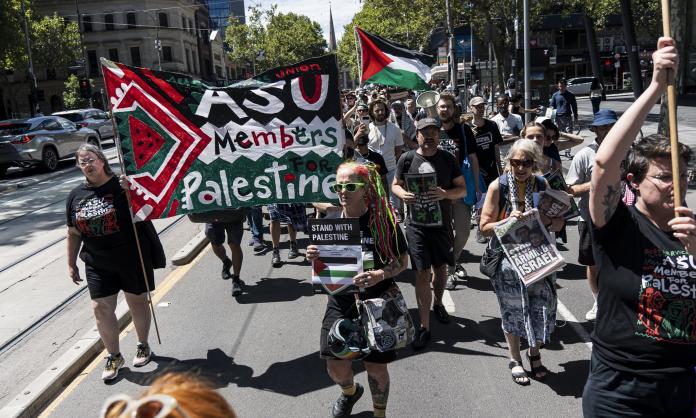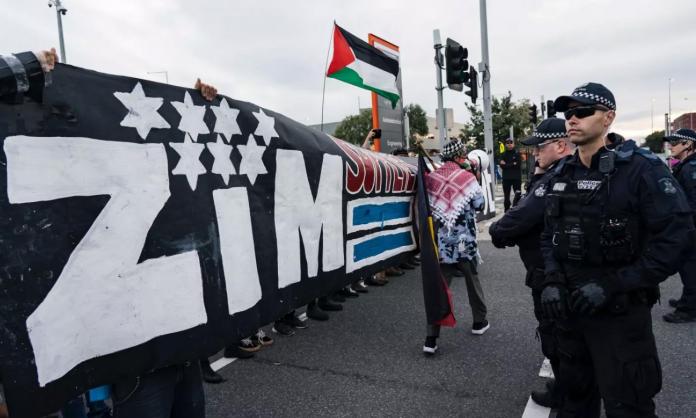Last summer brought record-breaking high temperatures across the country. Heatwaves are now the most lethal weather phenomenon in Australia, causing more deaths than all other natural disasters put together, according to a 2014 study.
As temperatures rise, working in extreme heat is becoming more common. This is resulting in more frequent cases of heat exhaustion, cramps, fainting, heatstroke and even death.
“We are expected to work [in the heat] at the same pace as any other day”, Sarah, a bakery worker in Melbourne’s northern suburbs, tells me, “sweat dripping and often feeling dizzy because it’s such a fast-paced workplace”.
Nick, who works in furniture removals, tells a similar story of physical stress. “Our body temperature is already high because of the work itself, but we work in the back of a truck that adds 10 degrees to whatever the temperature is outside – you’ve got a recipe for heat exhaustion and collapse. But even short of collapsing, working in the heat for too long causes a fatigue that’s like working drunk. In that state, you could drop a fridge on your foot or much, much worse.”
When I ask how workers are taken care of on hot days, Nick explains, “There is no heat policy at my workplace. No temperature too high to stop us working, no extra compensation and no health and safety officers keeping an eye on any jobs. No matter how hot it is, it’s business as usual”.
A warehouse worker, Omar, described conditions in his warehouse on a 35-degree day:
“It’s a massive tin shed with concrete floor – they’ve got a few vents in the roof or they open up a few doors. Then on hot days you get the hot wind come in and blow you in the face. So no temperature control at all. Sometimes they leave some Zooper Doopers out in an esky.”
The situation can be even worse for those working outdoors. Bob is a scaffolder and explains that the construction heat rule doesn’t cover everyone. “It really matters whether a site is unionised or not. Our company isn’t particularly unionised. A few weeks ago it reached 51 degrees on site and we were still erecting and dismantling scaffolding during the hottest part of the day.”
I ask what happens to bodies in that type of heat. “Heatstroke and sunburn are the main things”, he tells me. “Guys end up going home with heatstroke … My workmates say, ‘The heat sucks, but it’s our company that’s forcing us to work through it, and it’s big business and the government that make it this fucking hot in the first place’.”
Years ago, Anthony worked in WA’s Pilbara commissioning new locomotives for BHP, where he was exposed to the sun and heat for long periods. He described a day when the temperature reached 46 degrees by 9am. “There was a hot dry wind – a real desert heat; everything was shimmering. There was no shade, and the reflection off the concrete was searing. One of the contractors, young, perhaps 21 and an apprentice, was installing the fire-suppression equipment on the locomotives. He was carrying the cylinders, which were large and heavy on his shoulders. At the hottest part of the day, he suddenly collapsed. His workmates gave him some water and took him to the break room, which was air conditioned. He was faint and groggy. His condition didn’t improve, despite drinking plenty of water. By 11am he was delirious.” The worker was eventually taken to hospital, where he was diagnosed with heatstroke and put on a saline drip. “He could very easily have been another statistic”, says Anthony.
Anthony now works on Melbourne’s waterfront, where he says things are better. “The working in heat policy kicks in at 35 degrees”, he tells me, “and all work ceases at 38 degrees”. The reason is clear: “The historical gains that have been won in the past through struggle on the waterfront serve as a protection”, says Anthony.
An industry in which there have been organising efforts in this area in recent years is horticulture. Tim Nelthorpe works for the National Union of Workers organising farm workers. “In farms the biggest issue around heat is that workers get paid piece rates, so the pace they work at determines their wages. That obviously makes it harder to get a decent wage in extreme heat”, he says. “There are often cases of extreme heatstroke, exhaustion, sunburn, they often don’t have access to sunscreen or water. The extreme example is in Shepparton, where workers reported being exposed to crops that had been sprayed with harmful chemicals. You combine that with extreme heat and it can lead to the body reacting badly – workers suffered chest pains and bleeding from the nose and ears.”
While workers in specific industries have won the right not to work in high temperatures, there is no guaranteed right to a safe working temperature in Australia.
Nelthorpe is right to argue that workers unionising is the only way to fix the problem. “You can use HSR [Health and Safety Representative] rights to challenge [extreme heat], but it depends on the presence of the union among workers and their confidence.”
Back in the bakery, Sarah understands this problem: “Hospitality workers have a very low bar for safe and decent working conditions, so it’s hard to raise it as an issue and be taken seriously”.
Omar thinks his warehouse would fight if the union offered a lead. “Especially on hot days, everyone talks about how hot it is. If there was an awareness campaign about it, I’m pretty sure the workers would get on board. Especially when management is in nice air-conditioned offices and doesn’t need to worry about it.”
And Anthony knows that without workers being organised and willing to fight, things can get worse, even on the wharves. “It is an issue of concern given temperatures are increasing every summer. I can see employers would love to get rid of the restrictions, using WA as an example. They will simply say climate change brings about a new reality and we have to adjust to it.”
But wins are possible, as a recent campaign by transport workers shows. A union delegate working for Metro Trains told me about a campaign she was part of for the right to wear shorts instead of slacks on hot days – a demand which had been ignored for years. A few angry workplace meetings and a petition campaign last February forced Metro to change the policy within days.
Campaigns for workplace safety have been a constant in the labour movement, but decades of slow retreat and defeats for our side mean that today many workers lack the confidence to stand up against unsafe conditions. Hourly breaks, appropriate uniforms, air conditioning, smaller workloads, longer completion times and the right to delay work without loss of pay would all increase the safety of workers in high temperatures. It would also affect the bosses’ profit margins, which means challenging the prioritisation of profits over workers’ health.
With temperatures predicted to continue rising, unionists will need to offer a lead if we are to prevent dangerously hot working conditions becoming the norm.










